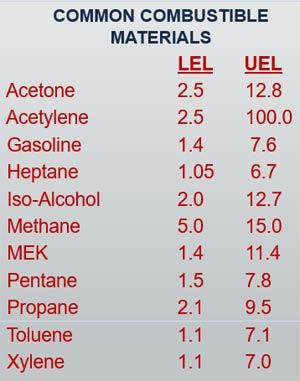
Blog Post #10 – In this post, we will examine the second category listed in the Federal OSHA definition for a hazardous atmosphere, which is an atmosphere with airborne combustible dust at a concentration that meets or exceeds its LFL (which stands for Lower Flammable Limit). LFL represents the minimum quantity of combustible dust that must be suspended in the air within the space to be able to cause a flash fire or dust explosion if ignited. In these conditions, the airborne dust is considered to have met or exceeded its lower flammable limit, or LFL.
OSHA’s 5-foot Rule of Thumb for Dust Measurement
The LFL of combustible dusts depends on many factors, including the type of material that makes up the dust, the size of the dust particles, the moisture content in the dust particles, and the density of the dust particles within the airspace.
There are instruments available that can measure the amount of combustible dust in the air to determine if it meets or exceeds its Lower Flammable Limit (LFL). However, for airborne dust measurement purposes, OSHA’s definition of a hazardous atmosphere due to airborne combustible dust refers to the use of the “5-foot rule of thumb”. That means that if the combustible dust suspended in the air is so dense that the entrant cannot see more than five feet from the end of their nose, there is a high risk of a flash fire or dust explosion.
In cases where this condition exists, or is likely to exist, inside of a confined space at any time during entry operations, it must be classified as a permit-required confined space.
Examples of Combustible Dusts
Here are examples of some, but not all, of the various types of airborne combustible dusts that could be present inside of some confined spaces during entry operations: Aluminum powder, dust from animal feed, coal dust, corn starch, cosmetic powders, dry fertilizer dust, dust from dry food and spices (coffee, tea, flour . . .), grain dust, powdered metal, plastic dust, powdered chemicals, rubber dust, sugar dust, textile fibers, and wood dust.
How Dust Fires and Explosions Occur
Combustible dust flash fires, a process called deflagration, is a rapid combustion process that produces a flame front which can quickly spread through a dust cloud if the concentration of combustible dust in the air is dense enough. And in some cases where the airborne dust fire is contained within a confined space, pressure quickly builds and an explosion can occur.
Here is a brief overview of the steps leading up to a combustible dust flash fire and explosion inside a confined space:
- A cloud of combustible dust is created in the air within a confined space, either through a process like grinding, mixing or other material handling activities, or by a settled dust being disturbed by other work activities such as cleaning with compressed air.
- A small portion of dust within the cloud is then ignited by a spark, flame, or other ignition source. Even static electricity must be considered as an ignition source.
- If the airborne combustible dust cloud is dense enough, the burning dust particles spread to others nearby, and those in turn ignite other airborne particles, resulting in a fire quickly spreading through the dust cloud. This process is called deflagration.
- The rapid spread of burning dust particles not only causes temperature inside the confined space to rapidly rise, it also creates a pressure wave that increases the internal pressure within the confined space.
- In the right conditions, the pressure wave can cause an explosion, leading to severe damage to the structure of the confined space.
- The burning dust cloud can continue to burn and expand. And the percussion from additional explosions may lead to more combustible dust inside the space being introduced into the air, adding even more fuel to the fire.
When a dust fire or explosion occurs, it can obviously lead not only to structural damage, but possible injury or death to anyone nearby. See an example of a dust explosion in this YouTube video showing a grain elevator explosion.
Classify All Confined Spaces with Potential for Airborne Dust Fires or Explosions as Permit-required Confined Spaces
So, consider the confined spaces present at your workplace, and take care to identify those with an actual or reasonable potential for a dense cloud of airborne combustible dust developing during entry operations, as those spaces will have to be classified as permit-required confined spaces.
Here are examples of some, but not all, types of confined spaces that, depending on materials they have contained, could produce heavy levels of airborne combustible dust during entry operations:
- Conveyor systems
- Cyclone separators
- Duct work and air-handling systems
- Dust collectors and bag houses
- Grain storage bins, elevators, and silos
- Hoppers and chutes
- Mixers and blenders
- Ovens and furnaces
- Powder processing equipment such as mills and pulverizers
- Truck and rail-car hoppers and tanks
In our next blog post (#11), we will examine the third criteria of a hazardous atmosphere that could be present inside of a confined space (oxygen deficiency or enrichment). In the meantime, please provide your feedback and questions to this blog post about airborne combustible dust at levels exceeding its lower flammable limit, or LFL, in the comments section below.
And as always, I hope you will take a moment to spread the word about our confined space training blog by share a link to this post with others in your network so they can benefit from this information. Thanks – Curtis

